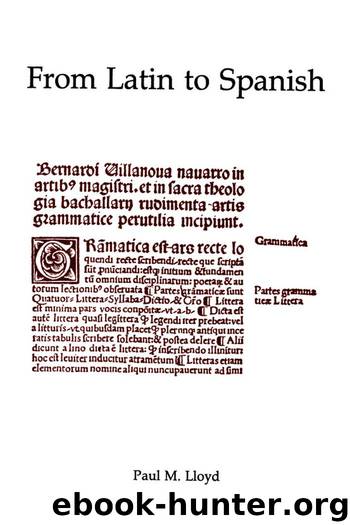From Latin to Spanish by Paul M. Lloyd

Author:Paul M. Lloyd [Lloyd, Paul M.]
Language: eng
Format: epub
Tags: Linguistics, General, Spanish, Foreign Language Study, .6VOCABBOOK, Language Arts & Disciplines, Latin
ISBN: 9780871691736
Google: -JZcAAAAMAAJ
Amazon: 0871691736
Barnesnoble: 0871691736
Goodreads: 1090067
Publisher: American Philosophical Society
Published: 1987-01-15T05:00:00+00:00
Some Portuguese words contrast conspicuously with their Castilian cognates that show the normal western change to /o/:
Curtu ‘shortened’ > Port. curto ‘short’ (Sp. corto)
CURVU ‘crooked’ > Port. curvo ‘curved, arched’ (Sp. corvo)
Fundu ‘deep’ > Port. fundo (Sp. hondo)
Ursu ‘bear’ > OPort. usso, Mod. Port. urso (Sp. oso)
Surdu ‘deaf > Port. surdo (Sp. sordo)
Plumbu ‘lead’ > Port. chumbo (Sp. plomo)
As we remarked in chapter 1, it would be possible to settle matters simply by deciding that all words showing the change of /u/ > /u/ must have been “learned,” i.e., borrowed from the innovative pronunciation of medieval Latin, rather than being ordinary popular words. Such a solution is certainly not impossible in a number of cases in which the word may have appeared frequently in religious contexts such as cruz, mundo, and sutna. In a number of cases, too, it might well be that special phonetic conditions favored the retention of the older M, e.g., when /u/ was followed by an implosive nasal, which, as we see in other words, sometimes does have the tendency to close slightly the preceding vowel, e.g., Comite > conde, OSp. cuemde ‘count’, Homine > Sp. hombre (found along with OSp. huembre). And, as we shall see later, the presence of a following yod can account for /u/ rather than /o/ in words containing the group /kt/, or the combination /-ult-/ (see the section on the various yods). When we have to do with other words containing an implosive liquid /-l/ the outcomes seem to be most irregular. In the case of cumbre, empujo, and azufre, the liquid has simply disappeared altogether. How then do we explain dulce? In medieval Castilian, in addition to the forms cited above we also find doz and doce, paralleling Port. doce. Evidently speakers created a number of by-forms which competed with each other until the modern form dulce came to dominate. And lastly we note those words containing another liquid, a syllable-final /-r/, such as hurto, and Port. surdo, curto, curvo.
Download
This site does not store any files on its server. We only index and link to content provided by other sites. Please contact the content providers to delete copyright contents if any and email us, we'll remove relevant links or contents immediately.
| Anthropology | Archaeology |
| Philosophy | Politics & Government |
| Social Sciences | Sociology |
| Women's Studies |
The Code Book by Simon Singh(3074)
Medea and Other Plays by Euripides(1402)
The Only Grammar Book You'll Ever Need: A One-Stop Source for Every Writing Assignment by Thurman Susan(1302)
Social Linguistics and Literacies by Gee James;(1118)
The Bostonians, Vol. II (Of II) by Henry James(1088)
The Dictionary of the Vulgar Tongue by Francis Grose(1054)
The Satyricon by Petronius(954)
Essential Words for the TOEFL by Steven J. Matthiesen(911)
Idylls of the King by Baron Alfred Tennyson Tennyson(901)
Words Fail Me by Patricia T. O'Conner(897)
The Fasti (Verse) by Ovid(894)
The Playboy of the Western World by J. M. Synge(877)
The Language Instinct: How The Mind Creates Language by Pinker Steven(844)
The Language Instinct: How the Mind Creates Language by Steven Pinker(815)
The Great Book of American Idioms: A Dictionary of American Idioms, Sayings, Expressions & Phrases by Lingo Mastery(808)
The Language Instinct by Steven Pinker(786)
The Riddle of the Labyrinth(774)
Don't Believe a Word: The Surprising Truth About Language by David Shariatmadari(756)
Rick Steves Germany 2017 by Rick Steves(737)
